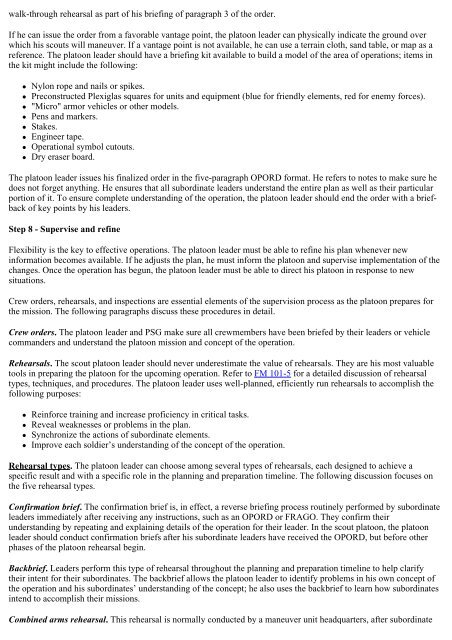FM 17-98 SCOUT PLATOON
FM 17-98 SCOUT PLATOON
FM 17-98 SCOUT PLATOON
You also want an ePaper? Increase the reach of your titles
YUMPU automatically turns print PDFs into web optimized ePapers that Google loves.
walk-through rehearsal as part of his briefing of paragraph 3 of the order.<br />
If he can issue the order from a favorable vantage point, the platoon leader can physically indicate the ground over<br />
which his scouts will maneuver. If a vantage point is not available, he can use a terrain cloth, sand table, or map as a<br />
reference. The platoon leader should have a briefing kit available to build a model of the area of operations; items in<br />
the kit might include the following:<br />
• Nylon rope and nails or spikes.<br />
• Preconstructed Plexiglas squares for units and equipment (blue for friendly elements, red for enemy forces).<br />
• "Micro" armor vehicles or other models.<br />
• Pens and markers.<br />
• Stakes.<br />
• Engineer tape.<br />
• Operational symbol cutouts.<br />
• Dry eraser board.<br />
The platoon leader issues his finalized order in the five-paragraph OPORD format. He refers to notes to make sure he<br />
does not forget anything. He ensures that all subordinate leaders understand the entire plan as well as their particular<br />
portion of it. To ensure complete understanding of the operation, the platoon leader should end the order with a briefback<br />
of key points by his leaders.<br />
Step 8 - Supervise and refine<br />
Flexibility is the key to effective operations. The platoon leader must be able to refine his plan whenever new<br />
information becomes available. If he adjusts the plan, he must inform the platoon and supervise implementation of the<br />
changes. Once the operation has begun, the platoon leader must be able to direct his platoon in response to new<br />
situations.<br />
Crew orders, rehearsals, and inspections are essential elements of the supervision process as the platoon prepares for<br />
the mission. The following paragraphs discuss these procedures in detail.<br />
Crew orders. The platoon leader and PSG make sure all crewmembers have been briefed by their leaders or vehicle<br />
commanders and understand the platoon mission and concept of the operation.<br />
Rehearsals. The scout platoon leader should never underestimate the value of rehearsals. They are his most valuable<br />
tools in preparing the platoon for the upcoming operation. Refer to <strong>FM</strong> 101-5 for a detailed discussion of rehearsal<br />
types, techniques, and procedures. The platoon leader uses well-planned, efficiently run rehearsals to accomplish the<br />
following purposes:<br />
• Reinforce training and increase proficiency in critical tasks.<br />
• Reveal weaknesses or problems in the plan.<br />
• Synchronize the actions of subordinate elements.<br />
• Improve each soldier’s understanding of the concept of the operation.<br />
Rehearsal types. The platoon leader can choose among several types of rehearsals, each designed to achieve a<br />
specific result and with a specific role in the planning and preparation timeline. The following discussion focuses on<br />
the five rehearsal types.<br />
Confirmation brief. The confirmation brief is, in effect, a reverse briefing process routinely performed by subordinate<br />
leaders immediately after receiving any instructions, such as an OPORD or FRAGO. They confirm their<br />
understanding by repeating and explaining details of the operation for their leader. In the scout platoon, the platoon<br />
leader should conduct confirmation briefs after his subordinate leaders have received the OPORD, but before other<br />
phases of the platoon rehearsal begin.<br />
Backbrief. Leaders perform this type of rehearsal throughout the planning and preparation timeline to help clarify<br />
their intent for their subordinates. The backbrief allows the platoon leader to identify problems in his own concept of<br />
the operation and his subordinates’ understanding of the concept; he also uses the backbrief to learn how subordinates<br />
intend to accomplish their missions.<br />
Combined arms rehearsal. This rehearsal is normally conducted by a maneuver unit headquarters, after subordinate











